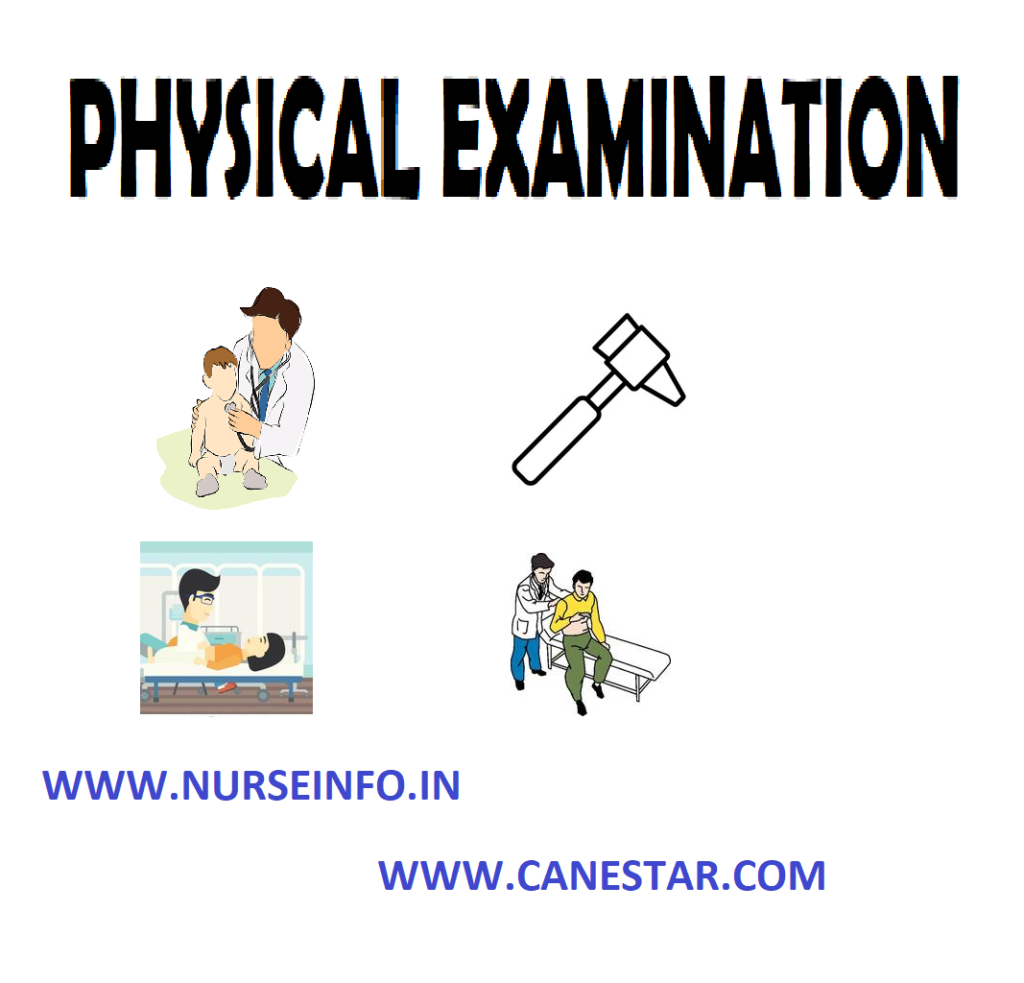PHYSICAL EXAMINATION (Introduction, Definition, Purpose and Methods of Examination)
INTRODUCTION
Assessment of physical findings should confirm data obtained in nursing history. Baseline information is obtained on admission. The proper examination proceeds logically from head to be starting with general appearance, blood pressure, pulse, hands and neck, heart, lungs, abdomen, feet and legs
DEFINITION
Physical examination is defined as a complete assessment of patient’s physical and mental status
PURPOSE
- To understand the physical and mental well being of the patient
- To detect disease in its early stage
- To determine the cause and the extent of disease
- To understand any changes in the condition of diseases, any improvement or regression
- To determine the nature of the treatment or nursing care needed for the patient
- To safeguard the patient and his family by noting the early signs especially in case of a communicable disease
- To contribute to the medical research
- To find out whether the person is medically fit or not for a particular task
METHODS OF EXAMINATION
Inspection
Visual examination of the body is called inspection. It is the observation with the naked eyes to determine the structure and functions of the body. It means looking with eyes. It reveals any rash, scar, color, size, shape, contour or symmetry of body parts. The quality of inspection depends on the time spent by the nurse to be thorough and systematic. In a hurry, we may overlook significant findings and make an incorrect conclusion. The following principles should be kept in mind for making accurate inspections.
- Good lighting and exposure are essential
- Inspect each area for size, shape, color, symmetry and proposition and find out any deviations from normal
- Use additional lights for examining body cavities, e.g. oral
- Use sense of olfaction along with visual to detect abnormalities e.g. bad breath indicates unhygienic mouth conditions. Acidic smell is significant of diabetic acidosis
PALPATION
It is feeling of the body or a part with the hands to note the size and positions of the organs. In palpation, the finger pads and not the fingertips are used. Palpation is an assessment technique in which the examiner feels with his/her fingers and one or both hands. Skill and gentleness are important. The degree of pressure applied during palpation varies, depending on, e.g. tenderness of the area and the depth of palpation required. It reveals may swelling, coldness, hotness, stiffness, hardness, smoothness, roughness, pain, vibration, firmness and flaccidity
The following points are to be kept in mind while doing palpation:
- The client should be relaxed and comfortable. Observe non-verbal signs of discomfort during palpation
- Palpation to be done with warm hands, short fingernails and a gentle approach
- Palpation to be done slowly and gently
- For light palpation the hand is depressed about 1 cm (1/2 inch) and for deeper palpation it should be approximately 2.5 cm ( 1 inch)
- Use appropriate parts of the hands for doing various palpations
PERCUSSION
It is the examination by tapping with the fingers on the body to determine the condition of the internal organs by the sounds that are produced. It is done by placing a finger of the left hand firmly against a part to be examined and tapping with the fingertips of the right hand. It means striking/tapping with fingers. It elicits sounds, which indicate whether the underlying tissues are solid or filled with air or fluid. The sounds may be:
Resonance: a low pitched and loud sound heard over the normal lung tissues
Hyperresonance: very loud, very low pitch sound longer than resonance and is of booming quality signifies emphysema
Tympany: a drum-like sound heard over the air-filled tissues such as gastric air bubble
Dull: a medium-pitched sound with a medium duration without resonance heard over solid tissues such as heart and liver
Flat: a high-pitched sound with a short duration without resonance heard over complete solid tissues such as hand, thigh
Method of percussion: the percussion can be done by two methods. These are:
- Direct percussion: striking the body surface directly with one or two finger, e.g. ascitic thrill
- Indirect percussion: placing the middle finger of the non-dominant hand firmly against the body surface and striking the distal joint of now-dominant finger with the middle fingers of the dominant hand
AUSCULTATION
It means listening with stethoscope/placing ear against the body. It reveals sounds produced within the body and the blood vessels such as heart beats, bowel sounds, while auscultation frequency loudness, quality and duration of the sound to be noted
MANIPULATIONS
It is the moving of a part of the body to note its flexibility. Limitation of movements is discovered by this method
Testing of reflexes: the response of the tissues to external stimuli is tested by: means of percussion hammer, safety pin, wisp of cotton, hot and cold water, etc
HEAD TO TOE PHYSICAL EXAMINATION
VARIOUS PREPARATIONS FOR PHYSICAL EXAMINATION



It’s very helpful thank you so much